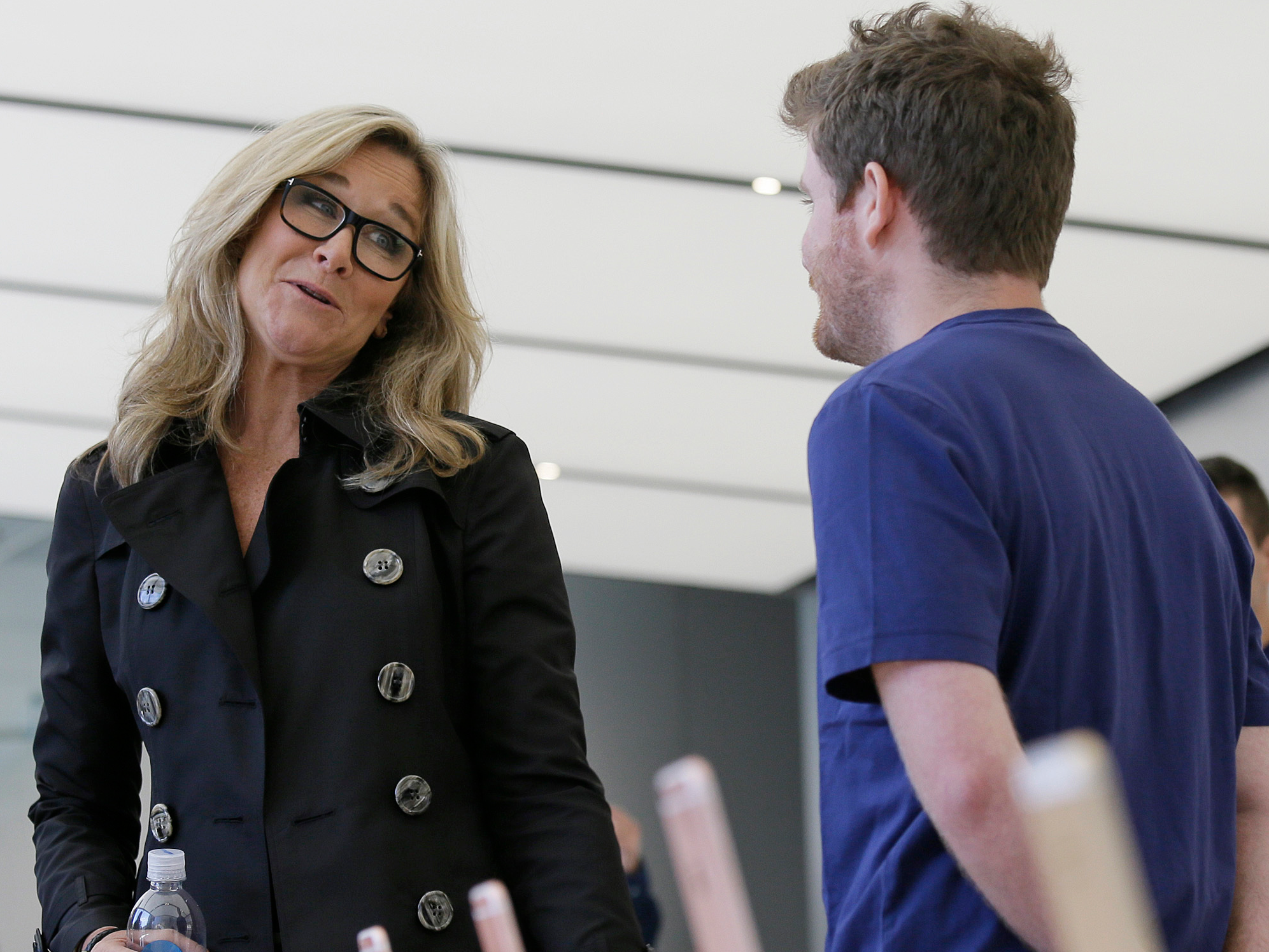- Apple’s head of retail, Angela Ahrendts, is leaving the company.
- In her five-year tenure, she spearheaded major changes to Apple’s retail division, including a store redesign and integration between online and physical sales.
- But there were also several missteps, including crowded stores and public opposition to new Apple locations.
At Apple, the head of retail is a major, public-focused position.
While Apple is a technology company, its stores – more than 500 across the world – are one of the main places where the company can speak directly to customers, fix their issues, and persuade them to buy new Apple computers.
In fact, Apple’s senior vice president of retail, Angela Ahrendts, is fond of calling Apple stores the company’s “biggest product.” Most of Apple’s full-time employees work in its stores.
But now, Ahrendts is out. In an announcement on Tuesday, Apple said Ahrendts would be leaving, and taking over for her would be Deirdre O’Brien, who runs Apple’s human resources and will add the retail division to her workload.
O'Brien has already started, according to a regulatory filing. Ahrendts will leave Apple on April 15.
Read more: Apple's retail chief, Angela Ahrendts, is leaving
Though Ahrendts was a public face of Apple, appearing at launch events and giving interviews, many consumers and Apple retail employees will remember her five-year tenure as a period of changes and challenges.
When she started, Apple's stores were already a juggernaut. Apple stopped reporting sales per square foot awhile ago, but a 2017 estimate from eMarketer said that Apple made more than $5,000 a square foot - higher than any other retailer.
Ahrendts oversaw a major redesign of Apple's stores, starting with the name - not Apple Stores, but just Apple, like Burberry, the fashion house she used to lead.
Under her supervision, Apple stores moved away from lines and the Genius Bar, where customers could sit to get their products fixed, and moved to a new paradigm, where Apple employees roam the floor and can help or check out customers from their mobile devices.
She also integrated Apple's online store and its retail arm, such that so many people were able to preorder and pick up iPhones on launch days that the famous line of fans became largely a phenomenon of the past.
"Ahrendts's signature accomplishment has been the unification of Apple's offline and online retail experiences; she also advanced the Today at Apple in-store experience," the Loup Ventures founder Gene Munster wrote in an email.
Significant challenges

Apple employees liked that Ahrendts was communicative and were surprised about the announcement. She posted regular video addresses to retail employees, which could be viewed on Apple's employee portal. She also regularly communicated with retail teams about why certain programs or products were being changed or added, an Apple technician told Business Insider, asking for anonymity because they are not allowed to speak publicly about their job.
Retail employees were informed of the changes in an email sent shortly after Apple's public announcement.
But there were significant challenges under Ahrendts as well. Stores are often overcrowded, especially during important periods like the holiday season. Apple stores became the de facto service center for iPhones purchased from anywhere, including from carriers and other retailers, straining limited resources. And the new system of hailing an Apple employee from anywhere on the show floor frustrated some people, who would've preferred lining up.
Apple's service problems got worse in the past year when the company was forced to offer new iPhone batteries for $29 after a scandal about software updates. Stores saw a major uptick in customers, causing crowding and unsatisfactory experiences. Daring Fireball's John Gruber said that Apple replaced 10 times the number of batteries it normally would, and several types of batteries were in short supply. Apple eventually had to bring in employees from other service-oriented parts of the business, as well as external contractors, to deal with the backlog, according to 9to5Mac.
Ahrendts wasn't immune to gaffes, either. At one iPhone launch, she referred to Apple's stores as "town squares," framing them as places to gather, instead of just buying things. This rhetoric dovetailed nicely with Apple's expanded classes, which teach people how to use Apple products and software.
But it also highlighted that Apple wanted to buy or lease long-term flagship properties in major cities around the world and transform them into stores, and it was the key phrase that protesters latched onto when fighting these planned Apple expansions. Protesters have already turned resistance into Apple's stores into major controversies in Stockholm and in Melbourne, Australia.
'This is what you were born to do'

Ahrendts also at times seemed uncomfortable leading a large division of retail employees. Before the Apple Watch launched, she said in an address to employees that "this is what you were born to do," annoying some retail employees who see their job as just one part of their lives.
Even Ahrendts herself seemed tired of a numbers-focused retail operation in a recent interview, and she seemed to wist for a smaller-scale, fashion-oriented challenge. (Apple retail employees are closely tracked with something called a Net Promoter Score, and even though Apple doesn't provide many metrics for its stores to investors, they're closely watched internally.)
"The tragedy in retail is that it has become about numbers," Ahrendts told Vogue Business. "It's about cost-cutting the way to prosperity instead of investing in your people, and in that environment, big isn't always good."
Apple has 70,000 retail employees out of its 132,000 total employees, and its median pay across the company is $55,426, which provides a ballpark for what most retail employees make. Ahrendts was one of Apple's highest-paid executives - she made about $70 million in stock grants when she joined Apple and $20 million to $30 million in total compensation most years.
What remains to be seen is how many of Ahrendts' changes will ultimately stick. As 9to5Mac's Michael Steeber, who follows Apple retail closely, tweeted: "It feels like Apple is evolving the intent of putting trees in its stores and deprecating the term 'Genius Grove.'"
But other changes, like the closer online-to-physical integration, will most likely stay in place for a while under O'Brien. She's an Apple lifer, having worked at the company for 30 years, and given her background in operations - CEO Tim Cook's specialty - she's likely to keep many of the Ahrendts-era changes in place and keep the trains running on time.

